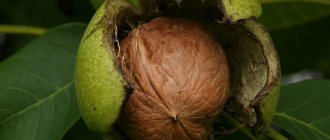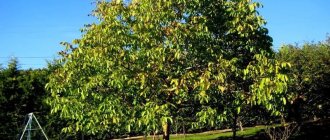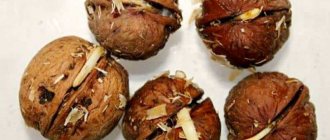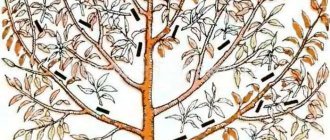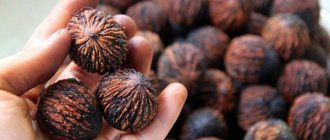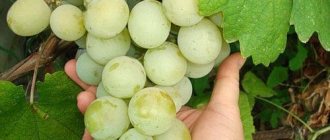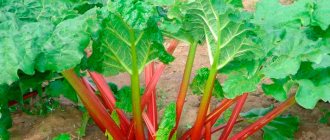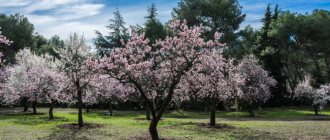A long-lived tree, the walnut retains the ability to bear fruit for up to 400 years, which is one of the highest among horticultural crops. Nut kernels and the oil extracted from them are considered the most valuable product, but man has learned to use all parts of the plant to their advantage: wood, leaves, bark, pericarp, shell.
Description of the species
Walnut tree (lat. Juglans regia) is a species of tree that is part of the genus Walnut (lat. Juglans) of the Walnut family (lat. Juglandaceae). It also has other names: Volosh nut, royal, Greek, Wallachian. Central Asia is considered the birthplace of the plant.
A seedling planted 50-70 years ago can reach up to 30 m, while the trunk is up to 1.5 m in diameter. The bark is painted in a dark gray shade, quite thick with deep cracks. The tap root goes to a depth of 3-3.5 m, but in trees older than 10 years, numerous horizontal root appendages are formed, giving life to lateral shoots.
The dense crown has a tent-like shape, forming a very dense shadow underneath. Thick curved branches are covered with long odd-pinnate petiolate leaves of complex shape, painted dark green. Each leaf has 7-11 oval pointed lobes, each 8-12 cm long.
In the last ten days of April, the buds burst on the tree and unisexual flowers appear along with the foliage. Staminate inflorescences look like pale green, freely hanging catkins. Pistillate inflorescences are formed close to the ends of the shoots and in the axils of the leaf petioles; they are sessile and have fused perianths. Pollination is cross pollination, mainly by wind. Walnuts do not require a pair to bear fruit successfully, but when pollinators are nearby, an increase in harvest volume is noted.
Walnuts (false drupes) ripen in the first half of autumn. The green fruit has a shell enclosed in a juicy green fibrous pericarp, which bursts when ripe, throwing the ripe nut out. The edible kernel of two halves is enclosed in a very hard shell, which has thin partitions inside. The weight of a walnut, including shells, ranges from 6-15 g, with the kernel accounting for 40-68%. Nut size – up to 5-6 cm in diameter
For the first time, a tree grown from a nut blooms 7-9 years after planting, but it will bear fruit only at 10-12 years, and reaches final maturity at 20 years. Typically, the fruiting period is 150-200 years. On average, a wild walnut lives up to 400-500 years. The oldest known tree is 2000 years old. Productivity depends on the variety. The most productive walnut variety among those commonly cultivated is “Bukovinsky - 2”, yielding up to 50 kg from 1 tree.
Watering mode
The frequency of watering directly depends on the frequency of precipitation and the age of the tree. Young walnut seedlings, from spring to autumn, need very abundant watering 2 times a month. However, if the summer turns out to be rainy, additional moisture is not needed to prevent the roots from rotting. In the absence of autumn rains, young hazel trees need moisture-replenishing watering for a good wintering.
Large nuts, whose height exceeds 4 meters, practically do not need watering (except for prolonged drought), since their powerful roots are able to take moisture from deep in the earth.
As for loosening the tree trunk circle after watering, this is often not necessary so as not to damage the roots. Two loosenings per season and autumn digging are enough. Walnut generally does not like excessive interference, and to protect the soil from the formation of a dry crust, it is better to use mulch.
Varieties
The future size of the tree, yield, taste of the kernels, thickness of the shell, shape and shade of foliage depend on which variety the seedling belongs to.
Walnut Chandler
The Pancake week variety of walnut comes from California, where it was obtained in 1979 and named after the famous American botanist William Chandler. In the USA it is the most common. Seedlings bear fruit 3-4 years after planting. Flowering is later, which serves as protection against late return frosts. 1 hectare of plantings yields a harvest of up to 4-5 tons. Oval smooth fruits are up to 4 cm in diameter, in the shell they weigh up to 16 g (the almost white kernel weighs up to 6.5 g). The variety has very high drought resistance. For cross-pollination, varieties Franguette and Fernette are recommended.
Walnut Robert Livermore
This variety is one of those that bear fruit already 3-4 years after planting. The red walnut was introduced in the USA in 1999 and became the basis for other red-fruited varieties. The unusual shade of the skin of the kernels does not radically affect the taste, but it looks advantageous in desserts, for which it has gained high popularity in cooking. A tree up to 6 m high usually blooms in May, and the fruits ripen in August-September. Frost resistance – down to -37°C. The variety is characterized by consistently high yield (up to 60-90 kg per tree) and resistance to diseases. The weight of a large fruit is up to 30 g, the taste is pleasant and oily.
Canadian Chandler
A low-growing variety of almost dwarf walnut (on average 3-5 m tall), bearing fruit even in the climatic conditions of the Moscow region. Seedlings after planting give the first harvest in the 3rd year. Flowering occurs in May, and the nuts ripen in September. On average, the weight of the fruit is up to 30 g, the taste is sweetish and oily. The shell is easy to clean. The highlight of the variety is the beautiful bright yellow color of the foliage in autumn.
How to plant walnuts in open ground
A walnut can grow and bear fruit for 100 years. For this reason, the place for planting it must be chosen very carefully.
Walnut loves a well-lit, sunny place with a low groundwater level. You should not plant it in lowlands where water often stagnates.
The walnut does not make any demands on the soil: it grows well on any type of soil and bears fruit well even on poor soils. Moreover, some gardeners claim that after applying fertilizers, the nut does not overwinter well, so they recommend not feeding it at all.
An adult tree grows large, so plant nuts at a distance of no closer than 8-10 m from each other. Take this into account if there are already trees growing nearby. You should not place a walnut near a house or other buildings.
How to plant walnut seeds
Prepare walnut seeds using one of the methods described above. Dig a small hole for planting. Its depth is three times the width of a walnut, i.e. approximately 7-9 cm. Water the ground. When the water is absorbed, lower the nut into the hole, sprinkle it with soil and tamp it down well. Water again.
When planting, you need to put the walnut in the ground not with a sharp or blunt end, but with its side, placing it on its edge.
When seedlings appear, monitor the humidity level and do not allow weeds to sprout. If necessary, cover the sprout from the scorching rays of the sun. In the first year, a walnut seedling can grow 25-30 cm high. For the winter, mulch the soil around it with a thick layer of peat or dry leaves.
How to plant a walnut seedling
When choosing a walnut seedling, pay attention to the roots, trunk and leaves of the tree:
- Roots: the root system of the seedling should be well developed, without damage or signs of rot. If you try to scrape away the top layer and healthy, fresh wood appears underneath, there is nothing wrong with the root system.
- Trunk: even, smooth, without cracks, tubercles or damage, the trunk indicates the good quality of the seedling. But a dry surface with various defects should alert you - it is better to refuse such a purchase.
- Leaves: Choose completely leafless seedlings because they take root more easily.
Experts advise buying annual walnut seedlings, because... they take root in a new place easier and faster than others. If you purchased a two-year-old seedling, after planting, shorten it to 50 cm.
The next stage of planting is preparing a hole for the walnut. Its size depends on the seedling, but the average size is 80x80 cm (the depth of the hole should be 20-30 cm greater than the longest vertical root). Dig a hole, setting the top - most fertile - layer aside. Then mix it with humus (1 bucket), wood ash (2 cups) and superphosphate (50 g).
Fill the hole with the prepared fertile mixture, leaving free space in the middle for the seedling. Lower the tree into the hole, carefully straighten the roots and fill the lower shoots with soil. Then gradually fill in all the roots to the very top. The root collar of a planted seedling should be at soil level. After planting, mulch the soil with straw and water it abundantly.
When planting a walnut seedling, some gardeners cover the bottom of the hole with a thick film. In this way, they stimulate the expansion of the root system: the film will prevent the growth of the vertical root, so increased development of lateral roots will begin.
Spreading
Today, plantings of cultivated varieties are found almost all over the globe. To this day, relict groves with an area of more than 25 thousand hectares have been preserved, in which only walnuts grow - in southern Kyrgyzstan, in the southwest of Turkmenistan.
In Russia, walnuts grow in mixed forests of the Krasnodar Territory, Crimea, Rostov Region, Kabardino-Balkaria, and the south of the Volga region. Wild varieties grow freely in northern India and China, mostly on gentle slopes and in mountainous gorges.
Why doesn't the tree bear fruit?
There are times when a walnut does not bear fruit, and there are reasons :
- It is typical for young trees in case of strong thickening of branches. It is necessary to remove excess branches and thin out the crown.
- Good growth, but no flowering. In this case, they say that “the tree has become fat.” It is necessary to stop watering and fertilizing. If this does not help, then you need to trim the roots.
- The walnut blooms, but does not form ovaries. Take a branch with ripe pollen and shake it over a tree where the ovary is not forming. That is, pollinate the nut artificially.
Planting and care
Walnuts are classified as heat-loving plants that require large amounts of sunlight for full growth and fruiting. The planting site is chosen on a slightly elevated sunny area with loose fertile soil, leaving 8 m between seedlings, and 10-12 m from nearby buildings. The optimal time for planting is the second half of April.
The land for planting walnuts is prepared in the fall. Dig a planting hole and mix the excavated soil with peat, humus, wood ash, and dolomite flour. Add 50 g of superphosphate. Planting holes are dug to a depth of 80-100 cm, and then filled back with refined soil and watered abundantly. In the spring in April, they are dug up again and a 15-20 cm layer of fine gravel or expanded clay is poured onto the bottom for drainage. A pole is driven into the bottom of the hole to secure a seedling 2 m high, since the tree grows quite quickly. The roots are sprinkled with fertile soil, the root collar is left 2-3 cm above the ground level. Water immediately, and the soil around the trunk is mulched with sawdust.
To successfully grow a walnut, a roller is erected from the soil around its trunk at a distance of about 50 cm, which does not allow water to spread after watering. For growth and fruiting, the plant requires a lot of moisture during the growing season. Mature trees draw it out from great depths, and young trees require watering every week (10-20 liters each).
Fertilizing is carried out twice a year. In the spring it is necessary to apply ammonium nitrate or superphosphate to increase green mass. In the fall, ammonium salts and calcium chloride are added for successful wintering; this is required even for frost-resistant walnut varieties - Chandler or Canadian.
Formative pruning is carried out on young trees in the fall to obtain a low-growing, spreading crown. To do this, in the first year after planting, only 3 main skeletal branches are left, and later, during the autumn pruning of the walnut, shoots directed vertically upward and thickening the crown are removed. In the spring, branches that have dried out during the winter and are broken are cut out. The root shoots of old trees are cut out or used for propagation. To protect against infection by diseases, all cuts must be coated with garden varnish.
Planting a walnut
When is it better to plant walnuts using seed propagation? This can be done in spring and autumn. Each option has its pros and cons.
Autumn planting of walnuts:
- plus - you can plant immediately after harvesting fresh nuts, without any additional preparation;
- minus - during a long winter, the contents of the nut may simply rot, so you will never see the sprout.
Spring planting of walnut
- plus – the chance of seed germination is much higher;
- minus - additional multi-month stratification is required.
Thus, autumn planting is usually used in the southern regions. In more northern latitudes, where winter is very cold or frosts are often replaced by thaws, spring planting of walnuts is preferable.
As for planting walnut seedlings, they are planted both in spring and autumn. When planting in spring, be sure to monitor the soil moisture, because without watering the seedling will die. In autumn, be sure to insulate the seedling before the onset of frost. If your region has very frosty winters, then spring planting is preferable.
Reproduction
Today, two main methods of propagation are used: nuts and grafting. The first method has a significant drawback - a nut tree will produce fruits only in the 10th year of life, not earlier, but they will certainly differ from those of the mother. Modern hybrids and varieties are propagated by grafting onto winter-hardy wild varieties; they can be found in any garden nursery. Such specimens begin to bear fruit in the 3rd or 4th year after planting.
If the seed method is chosen, then ripe walnuts are collected in the fall. Collected in September, peeled from pericarp and dried, ripe nuts are placed in the refrigerator for 3 months for stratification to improve germination. Planting is carried out in April in open ground to a depth of 12 cm. The seedlings require mandatory shelter for the winter in the next 5-6 years.
You can also grow walnuts from root shoots. Its characteristics are identical to garden seedlings, that is, such trees will begin to bear fruit earlier - in the 3rd or 4th year after planting. The only drawback is that the fruits will be the same as the root part should be. This means that in grafted specimens the root shoots will not produce the same nuts as the parent crown.
Growing a walnut tree from a walnut
Many people ask the question, how to plant walnut trees at home? The answer is very simple, you need to dig the nut into the ground in the fall to a depth of about 10 cm. It is laid on its side, with the joint of the peel halves facing down.
Japanese quince: description of the plant, features of planting and care. 100 photos and videos of applications for decorating an ornamental garden
Where cherries grow - conditions for the maintenance and growth of the tree. Tips for choosing a place on the site and choosing neighbors for cherries (145 photos)
- Poplar tree: description of the main types and beneficial properties of the tree. Tips for choosing a place for planting and care features (110 photos and videos)
After such planting, young shoots begin rapid growth the following year. The first fruitful nut may appear in the second or third year. And having already reached ten years, the tree gives a full harvest.
To plant a tree, you should choose a place where it will be least exposed to cold wind and drafts. But he should have a lot of sun. By observing these small requirements, the walnut will delight its owner with a good harvest.
Diseases and pests
Due to waterlogging of the soil and excessive application of nitrogen fertilizers, fungal diseases - marsoniosis and bacteriosis - may appear on walnut leaves. They appear in the form of black, brown or gray spots. For prevention, you should strictly follow the dosage of fertilizers, in the spring you should clear the trunk circles of weeds, and cut out the affected branches. Also, before the buds open, spray the crown with a 1% solution of copper sulfate.
Brown growths on the roots and in the lower part of the trunk are root cancer, which affects young plants more. It is necessary to cut out the formation and treat the cleaned sections with caustic soda, and then rinse with water.
Spring whitewashing of trunks helps prevent aphids and caterpillars from attacking garden crops. For preventive purposes, spraying with Aktara, Antitlin or Actellik is carried out twice with an interval of 7 days at the end of April.
Features of caring for young plants
The rules for caring for adult walnuts differ significantly from those used when growing seedlings of this plant. The first thing you should pay attention to is feeding the seedling. Young plants do not need much fertilizer.
For the first couple of years after planting a seedling in open soil, feeding it is not recommended at all. Despite the fact that in this case the growth of the plant will be slower, its skeleton will become very powerful and strong.
At one year of age, the tree will need formative pruning, which is carried out only once. It is necessary in order to give the crown the correct shape. During the period of active growth, not one powerful shoot, but several, can grow on the pole. In this case, it will be necessary to select a leading shoot. Only it should be left untouched on the seedling, and all excess shoots should be pinched.
In this case, the young plant will spend all its energy on the development and growth of the “leader”, while the remaining shoots will act as an assimilation apparatus. In addition, further development of pinched shoots is completely stopped.
Meaning and Application
Patterned in the cut, light and durable wood served as a material for the manufacture of furniture, butts of rifled weapons, and decorative items. It is soft enough to produce carved products, but does not lose its shape over time, like pine.
The main value is the fruit, which is an indispensable ingredient in numerous recipes for sweet dishes in many national cuisines of the world. Walnuts are harvested in the fall, waiting until the pericarp valves open on their own and the crop falls to the ground on its own.
Children over 3 years of age are allowed to eat it, as walnuts contain iodine and can cause an allergic reaction. It is not recommended to include it in the diet of pregnant and lactating women. The kernels contain up to 77% fat, up to 21% protein, vitamin B1 and provitamin A. Walnuts are rich in oil, which is a valuable food product, but it is also used in other areas - to produce high-quality varnishes, paints, soaps, etc.
The most iodine and phenols are found in nut leaves and pericarps, so if handled improperly, they can be harmful to health. In folk medicine, they are used to cauterize wounds that do not heal for a long time, for disinfecting purposes. The positive effect of nuts on hormonal levels, potency, and for restoring strength after physical exertion and illness has long been known.
Use in landscape design
In the garden, even a dwarf walnut is a tapeworm that does not tolerate any proximity. Its rapidly forming spreading crown does not allow sunlight to pass through, so even weeds grow extremely poorly in such shade. Do not plant fruit bushes, flowers or other trees next to walnuts. The only option is a lawn, but even here you have to take into account that near the trunk the grass will be limp and pale.
The leaves that fall every autumn contain a lot of iodine, so they are absolutely not suitable for use in the garden as mulch. All of it is raked in October, dried in heaps and burned. However, ash from burning branches and leaves is a valuable mineral fertilizer.
When choosing a place for planting, take into account the need to maintain a distance from other plantings, as well as the attractiveness of the crown in summer and autumn. In the summer, the walnut is covered with very large green leaves that turn bright yellow or orange in the fall. Thick, intricately curved branches look quite attractive even in winter under caps of snow.
Areas of application of fruits
The nut kernels are not processed, but are used in their original form. The main area of application is the confectionery industry. The nut is added to cakes, pastries, halva and other desserts. Suitable for the production of oil used in the food industry. The cake is consumed by livestock.
The wood is polished and has a beautiful pattern. Wood is a valuable material used to make furniture and plywood sheets. The husk of the nut is used in the production process of a black dye used in the dyeing of materials in the cloth industry for the production of fabrics.
How to germinate them correctly
If in the open ground nuts begin to germinate in the autumn, then at home this is done in the spring after stratification. There are different ways to plant plants in an apartment.
Different ways
Most gardeners believe that it is easiest to germinate a nut by planting it directly in a pot of soil. To do this, use a plastic container, a wooden or clay tub about 30 cm deep. The container is filled with a soil mixture prepared from:
- 3 parts peat,
- 3 parts garden soil;
- 1 part humus.
The components are mixed and calcined in the oven or poured over with a dark pink solution of potassium permanganate. The planting container is doused with boiling water or soaked in a strong solution of potassium permanganate.
Important! There must be drainage holes in the bottom of the planting container.
For planting, you will need drainage, for example, crushed bricks, small crushed stone, broken ceramics, coarse sand, or special purchased drainage for plants. It is also disinfected.
Step-by-step planting instructions:
- The pot is filled with a layer of drainage no less than 5 cm high. The rest of the volume is filled with soil.
- Planting material is planted in individual containers to a depth of 7-9 cm. The nut is laid on its side.
- The soil is watered generously with water at room temperature. Some gardeners add a growth stimulant (“Epin”, “Kornevin”, “Rastvorin”) to the water during the first watering.
- Cover the container with film and put it in a warm, bright place. The soil is watered as it dries. To prevent mold from forming, it is ventilated.
After germination, the nut begins to harden. To do this, open the film slightly, gradually increasing the time of such ventilation. Then it is completely removed.
You can germinate nuts in water. This is done at the end of winter or beginning of spring, when the heating is still working. For this:
- Fill the jar one third with warm water. A nut is placed in it, sealed with a lid and placed on the battery. The planting material is left in this form for 2-3 days. During this time, it should be saturated with moisture, and the shell flaps should open slightly.
- After 3 days, all the water is poured out of the jar. 0.5 cm of warm water is poured into the bottom of the container, then planting material is placed in it. The lid is left slightly open to allow air circulation. After 10-14 days, a sprout should appear and grow.
- Together with the shell, it is transplanted into a container with soil so that the regrown part is above the surface of the soil. Keep the plant in a warm, bright place and water as needed.
Green (unripe) walnuts, which are used to make jam, are not suitable for planting. Its core is not yet formed, so it will not sprout.
Care during germination
In order for the sprouts not only to look, but also to be healthy and strong, to take root well after planting in open ground or a large container, it is important to properly care for them and provide optimal conditions:
- Lighting. A light-loving walnut tree, even at the stage of growing a seedling, must receive enough light. It is best to keep it on a south or west windowsill. If this is not possible, use fluorescent lamps.
- Temperature. The tree does well at room temperature. If it is warm outside, be sure to ventilate the room.
- Hardening. The walnut tree begins to be taken outside when the air temperature reaches +15°C. The plant is brought in at night. In the summer, when the nights are also warm, you can leave the nut overnight. Then the plant will easily survive transplantation into open ground. It is also useful to take indoor nuts outside.
- Watering. The sprouts are watered as the soil under the root dries. It is important that the soil does not dry out, but that the moisture does not stagnate.
- Mulching. In order for the tree to form a strong root system that quickly adapts to new conditions after transplantation, its base is mulched with peat.
- Feeding. Complex fertilizers containing potassium are applied once every 2 weeks. For sprouts, use a concentration of half the norm.
How to achieve early fruiting?
The growth and development of a young nut seedling takes time, which means you will be able to try tasty and healthy nuts no sooner than in 2-3 years. Not all gardeners like this state of affairs, so many of them try to artificially speed up the time of harvesting the first harvest. There are several ways to do this.
Important! Such transplants can be performed only in the spring, using healthy young plants of the second or third year of cultivation.
The simplest option would be to replant the plant two or three times, with intentional damage to the vertically growing roots (mechanical impact should be moderate, otherwise the plant will die). If you believe the reviews, then such actions stop the growth of the crop in height and activate the development of flower buds.
The second, no less well-known way to accelerate the fruiting of walnuts is ringing, which is performed in the middle of the summer season, having previously selected only four- or five-year-old plants. The process itself involves organizing a circular cut on a skeletal branch, only so as not to touch the wood (only the bark is removed).
A similar ring is made a little higher (approximately 2 cm from the first mark), covering the wound surface with garden varnish. Such measures will stimulate the redirection of the plant’s vital juices from the root system to the generative buds, which will contribute to their rapid development and further formation of fruits.
